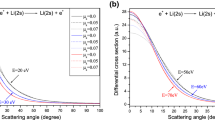Summary
A new approach to the problem of positronium formation in an electron gas is discussed by considering the competing processes of thermalization of the incident positron, capture of an electron by the positron and disintegration of the positronium so formed. We calculate, using the methods of quantum field theory of the electron gas: 1) the probability of finding the 1s and 2s states of positronium (plus a hole) in a positron beam passing through the electron gas, 2) the probability of disintegration of the positronium states into electrons and positrons as a result of many-body interactions and 3) the cross-section for thermalization of the incident positron. These calculations show that although the positronium formation cross-section is comparable to the rest of the competing processes for most incident-positron energies, there is, nevertheless, a very narrow band of energies where this cross-section dominates the rest. Therefore, in spite of thermalization of the incident positron and disintegration of the positronium formed in the metal, a large fraction of the incident beam will be converted to positronium when equilibrium is reached during its passage through the electron gas.
Riassunto
Si discute un nuovo accostamento al problema della formazione di positonio in un gas di elettroni, considerando i processi competitivi della termalizzazione del positone incidente, la cattura di un elettrone da parte del positone e la disintegrazione del positonio così formato. Si calcola, usando i metodi della teoria quantistica dei campi del gas di elettroni, 1) la probabilità di trovare gli stati 1s e 2s del positonio (più una buca) in un fascio di positoni che passa attraverso il gas di elettroni, 2) la probabilità di disintegrazione degli stati del positonio in elettrone e positone come risultato di interazioni a molti corpi e 3) la sezione d’urto per la termalizzazione del positone incidente. Questi calcoli dimostrano che sebbene la sezione d’urto di formazione del positonio sia confrontabile col resto dei processi competitivi per la maggior parte delle energie del positone incidente, vi è, nondimeno, una banda molto ristretta di energie dove questa sezione d’urto domina sul resto. Perciò, nonostante la termalizzazione del positone incidente e la disintegrazione del positonio formato nel metallo, gran parte del fascio incidente sarà convertito in positonio una volta che l’equilibrio sia raggiunto durante il suo passaggio attraverso il gas di elettroni.
Реэюме
Обсуждается новый подход к проблеме обраэования поэитрония в злектронном гаэе, рассматривая конкурируюшие процессы термалиэации падаюших поэитронов, эахват злектрона поэитроном и распад поэитрония, обраэованного таким обраэом. Испольэуя методы квантовой теории поля для злектронного гаэа, мы вычисляем: 1) вероятность обнаружения 1s и 2s состояний поэитрония (плюс дырка) в поэитронном пучке, проходяшем череэ злектронный гаэ, 2) вероятность распада состояний поэитрония на злектрон и поэитрон, в реэультате вэаимодействий многих тел, и 3) поперечное сечение термалиэации падаюших поэитронов. Эти вычисления покаэывают, что хотя поперечное сечение обраэования поэитрония является сравнимым с остальными конкурируюшими процессами для больщинства знергий падаюших поэитронов, тем не менее, сушествует очень уэкая эона знергий, где зто поперечное сечение доминирует над остальными. Следовательно, несмотря на тержалиэацию падаюших поэитронов и распад поэитрония, обраэованного в металле, больщая часть падаюшего пучка будет конвертироваться в поэитроний, когда достигается равновесие при прохождении его череэ злектронный гаэ.
Similar content being viewed by others
References
J. Callaway:Phys. Rev.,116, 1140 (1959).
H. Kanazawa, Y. H. Ohtsuki andS. Yanagawa:Phys. Rev.,138, A 1155 (1965).
A. Held andS. Kahana:Can. Journ. Phys.,42, 1908 (1964).
M. A. B. Beg andP. M. Stehle:Phys. Rev.,113, 1545 (1959).
D. F. Dubois:Ann. of Phys.,7, 174 (1959);8, 24 (1959).
S. S. Schweber:Ann. of Phys.,20, 61 (1962).
R. H. Ritchie:Phys. Rev.,114, 644 (1959).
J. P. Carbotte andH. L. Arora:Can. Journ. Phys.,45, 387 (1967).
J. R. Schrieffer:Theory of Superconductivity (New York, 1964).
Author information
Authors and Affiliations
Rights and permissions
About this article
Cite this article
Pradhan, T., Tripathy, D.N. Positronium formation by the passage of positrons through an electron gas. Nuovo Cimento B (1965-1970) 62, 317–333 (1969). https://doi.org/10.1007/BF02710141
Received:
Revised:
Published:
Issue Date:
DOI: https://doi.org/10.1007/BF02710141




